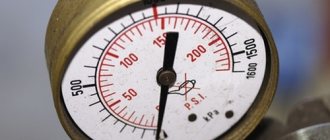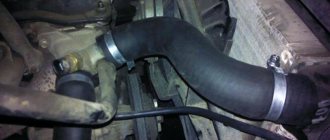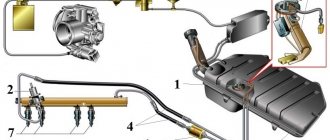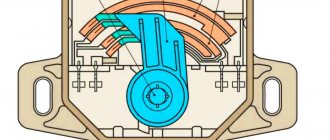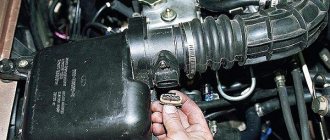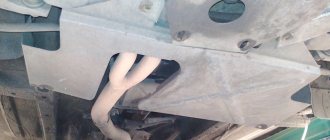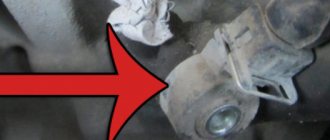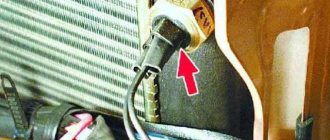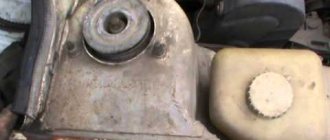When gasoline comes into contact with air, vapors are released, which, when released into the atmosphere, worsen the environment. To catch them, an adsorber is installed in the ventilation system of the gas tank. In a number of European countries, the use of this device in a car is mandatory at the legislative level and is determined by environmental standards Euro-2 and higher. Knowing the adsorber device and why it is needed, you can easily identify malfunctions, as well as better understand its benefits.
What is an adsorber in a car, why is it needed and where is it located?
Today, the European environmental standard “Euro-3” is in force, according to which the emission into the atmosphere of hydrocarbon vapors resulting from the combustion of fuel is prohibited. To implement this task, a special device was developed - an adsorber.
The name of the device comes from the word adsorbent (absorbent composition). The unit is mounted in the fuel system of a vehicle in order to absorb harmful vapors arising during the evaporation of fuel.
The absorbent is activated carbon, which fills the tank. It is this that absorbs harmful substances when the engine is not running. Otherwise, the vapors are sucked into the intake pipe and burned in the engine along with the combustible mixture.
This feature helps to increase the efficiency of the car. The result is a double effect: fewer harmful vapors enter the atmosphere and the combustible mixture is saved.
An adsorber is a filter element that becomes dirty over time and its effectiveness decreases.
The main sign of a malfunction is a “hissing” sound when the fuel tank cap is unscrewed. This happens due to the fact that fuel vapors have nowhere to go, and they “rush” out with all their might.
The location of the adsorber varies depending on the make and model of the car. So, in VAZ cars the device takes the form of a black can with a cylindrical shape. The device is often located on the right side in the direction of travel, in the near corner (near the headlight).
But for each model, the manufacturer determines the location of the device individually.
For example, in the VAZ 21099 the absorbent injector is located like this.
Absorber valve: what is it for and what does it affect?
The valves in the absorber are a technically simple device that operate differently depending on whether the engine is running or not. Like all valves, it must open and close.
When the absorber cavity is clogged or some other malfunction occurs, the valve malfunctions. With a faulty adsorber valve, serious vehicle damage can occur because pressure is not released from the fuel tank and the cavity is not purged.
Symptoms of Absorber Valve Problems
There are several signs and symptoms that can help identify the technical condition of the valve:
- The fuel gauge shows either a full tank or an empty one.
- After starting the engine, after 5-10 minutes the revolutions begin to fluctuate.
- At idle speed, when you press the pedal, the car begins to stall.
- The engine does not gain speed when driving. It takes a long time to accelerate.
- When opening the gas tank cap, a vacuum is felt and a whistle is heard.
- Increased fuel consumption.
- When it’s cold (when the engine is running but not yet warmed up), knocking noises from the absorber are heard, as if valves are knocking.
The cause of absorber failure is not always the valve. This may be severe contamination of the absorbent element, in this case coal. Gases should easily pass through the coal granules and condense there.
The valve is very cheap. Therefore, it is possible to change if signs of improper engine operation are detected. You can also replace the adsorber filter element with your own hands: disassemble it, pour out the old coal, pour in new coal in large granules.
From what Euro standards is it established?
According to international requirements, the installation of an adsorber is mandatory on cars with Euro-2 standards and higher. As for the standard known in Russia (Russia-83), there is no installation of an adsorber here.
So, in VAZ-2108 cars there is no adsorber. Here the separator and the fuel tank are connected to each other using a drain tube.
During operation, condensation occurs and returns to the fuel tank.
In addition, the separator interacts with the atmosphere using a 2-way valve, which does not allow the pressure in the tank to increase or decrease.
The connection between the tank and the neck occurs using a gasoline-resistant tube, fixed with clamps. It turns out that when the pressure in the tank decreases (increases), fuel vapors escape into the atmosphere.
The system is organized differently in VAZ Priora cars. Here, the fuel vapors that entered the separator from the fuel container condense. The condensate then accumulates and returns to the tank.
A gravity valve is mounted in the upper part of the separator, which prevents the fuel mixture from leaking out of the tank if the machine overturns.
If the engine is started, the vapors of the fuel mixture are mixed with air masses and discharged through the throttle assembly into the intake pipe - to the cylinders of the power unit.
It turns out that fuel vapors in a stationary position of the car accumulate in the adsorber, and if the car is moving, they are purged by the valve and sent to the receiver and to the engine for afterburning.
According to Euro-2 requirements, the fuel tank ventilation must not come into contact with ambient air, and vapors must be collected and directed to the engine (or adsorbed by the device in question).
As for the Russia-83 standards, contact between the atmosphere and ventilation of the fuel bank is not prohibited.
Why do you need an adsorber?
The first development of a car adsorber appeared as an additional system that increased the environmental friendliness of the car. Thanks to this device and the modernization of the power unit, the car could comply with the Euro2 eco-standard. This system itself is not needed for better engine performance. If you correctly adjust the gasoline injection , set the ignition and equip the car with a catalyst , the vehicle will comply with more stringent environmental standards.
This system was not used in carburetor engines. For this reason, there is always the smell of gasoline near an old car. If the vehicle is stored outside, it is hardly noticeable. But it is no longer possible to stay in a garage next to such a car for a long time without signs of gasoline vapor poisoning.
With the advent of injection internal combustion engines, the adsorber is an integral element of any car. The fact is that the environment is polluted not only by the removal of exhaust gases through the exhaust pipe. Gasoline vapors also enter the air, and even the highest quality engine with a modern exhaust gas purification system without this system for purifying vapors generated in the gas tank will not meet the high requirements of environmental protocols.
On the one hand, it would be possible to close the gas tank hermetically, and the problem is solved - the fumes do not enter the environment. However, this would not mean that gasoline would stop evaporating. As a result, the pressure in a sealed tank (especially during the hot season) will increase. This process is undesirable for the fuel system. For this reason, the tank must have ventilation.
It turns out to be a vicious circle: the tank cannot be closed hermetically so that gasoline vapors do not increase the pressure in it, but if ventilation is provided in it, these same vapors inevitably enter the atmosphere. The very purpose of the adsorber is to maintain the pressure in the tank at atmospheric level, but at the same time the environment is not polluted with harmful fumes.
In addition to environmental concerns, automakers have improved the safety of the vehicles themselves. The fact is that when the car is stored in a garage, without an adsorber, the air near it will be saturated with toxic fumes. Inevitably, this air enters the vehicle interior. Even with the windows open while driving, it will take time for these volatile substances to dissipate. Because of this, the driver, as well as all passengers, partially inhale polluted air and are poisoned.
The adsorber device, together with which devices it works
The device for absorbing harmful vapors of the fuel mixture consists of the following components:
- adsorbent composition (activated carbon);
- gravity (electromagnetic) valve;
- separator;
- purge valve;
- fuel drain pipes;
- steam hose.
The basis of the design is the adsorber, whose task is to collect harmful vapors that come from the fuel tank and prevent them from entering the atmosphere.
In this case, the adsorber will combine with:
- Fuel tank;
- Intake manifold;
- Atmosphere (through a separate valve installed on the air filter or at the inlet to the device).
The system valve is an actuator that combines the adsorber and the intake manifold.
How the adsorber works in a car: EVAP system
Despite the design differences and differences in the location of key elements, the air purification scheme from volatile fuel substances in all machines will work on an identical principle. The key element that purifies the air from unpleasant evaporation is a container filled with activated carbon.
After condensation, gasoline vapors enter the cavity of the container through a hose through a gravity valve. While the car engine is not running, the pressure in the tank increases and vapors accumulate in a special reservoir in the adsorber tank. Gradually, excess pressure forces excess air through the coal and out into the atmosphere. At the same time, the gasoline smell and harmful volatile substances are retained by the neutralizing agent.
The adsorber device has another valve, but it is already electromagnetic. When the internal combustion engine starts, the microprocessor (electronic control unit) controls the operation of this mechanism. The second canister circuit is connected to the intake manifold through a fitting connected to the same fuel tank.
When the pressure in the tank increases, the solenoid valve is activated. Since a vacuum is created in the intake manifold, gasoline vapors are sucked in, but in this case they no longer go through the carbon filter into the atmosphere, but along an easier path - into the intake system (more details on how it works are described separately ).
To prevent vacuum from forming in the gas tank due to the operation of the cleaning system, which would impede the operation of the gas pump, there is an air fitting in the adsorber tank. Through it, fresh air flow enters the separator if all excess vapor has already been removed. This process is called purging.
The advantage of such a system is that while the motor is running, the carbon filter remains unused. When gasoline vapors enter the vehicle's intake system, harmful substances are burned during the operation of the cylinders. Next, the exhaust gas stream is neutralized in the catalyst. Thanks to this, the smell of unburned gasoline is not heard near the car.
Principle of operation
Operating principle of the adsorber:
- When the car is stationary and the engine is turned off, excessive pressure of fuel vapor is formed in the fuel tank, which rises through the pipeline and is sent to the adsorber.
- The engine is running. The ECU (electronic control unit) of the machine, taking into account the current program and operating mode of the power unit, commands the solenoid valve to open.
- Fuel vapors accumulated in the adsorber are blown out through the vacuum that takes place in the intake manifold.
- Next, the vapors are sent to the intake manifold itself and to the combustion chamber. The result is obvious - the vapors burn out. As for the volume of vapor that enters the manifold, it depends on the opening time of the EM valve. The longer the path is open, the greater the volume of vapor available for combustion.
Motors equipped with a turbine have a compressor. The latter's task is to create a vacuum in the intake manifold.
That is why in special systems that provide vapor recovery on turbocharged engines, a 2-way valve is installed that operates and directs fuel vapor to the compressor inlet or into the intake manifold (in the presence or absence of pressure, respectively).
Possible malfunctions in the operation of the device
The VAZ 2114 absorber, due to its intended purpose, is susceptible to clogging and at some point may become faulty. Problems are not easily determined and often only by secondary symptoms, for example, increased pressure in the fuel tank. It’s just that gasoline vapors, due to wear of the separator, remain locked in the space of the tank and begin to put pressure on its walls. An increase in pressure can be detected when unscrewing the tank cap - a characteristic hissing sound is heard.
Sometimes the gas tank cap simply shoots out of the neck, which means that the pressure has reached a critical level and the adsorber must be urgently changed. If there is a problem with the adsorber, the engine speed begins to jump up and down. Many car owners write on forums that you can remove the VAZ absorber and not suffer. But everything is not so simple, and there are never unnecessary parts in cars.
Removing the absorber alone is not enough; you need to think about what to do with gasoline vapors that have nowhere to be discharged, and that the ECU may also have to be reconfigured. After all, some types of on-board engine processors find a malfunction in the purging of the fuel system and put the engine into emergency mode, in which it will not be possible to drive normally.
As for malfunctions, the problem area of this adsorbent system is the purge valve. You can repair it yourself. All you need is a flathead screwdriver, but be careful when removing it. The problem is the valve fastening; often it is not metal, but plastic; it is not difficult to break. The mount is located on the engine cover. There are also clamps on the valve itself, which also require a careful approach. We remove them and take out the problematic part.
If you blow into the valve and air comes out of it, this means a 100% malfunction. A normal part will not allow air to pass through. If there is a problem with the valve, the car experiences problems when starting the engine hot, and gasoline consumption increases. If the problem is not corrected, there will be a Check Engine and loss of normal driving dynamics. Failure of the adsorber seal and failure of the purge valve can cause unstable engine operation at idle until it stops.
So, let's move on to valve repair. In its upper part there is an adjusting screw fixed with epoxy resin. Screw the screw in until it stops, counting the turns so that if something happens, you can return the canister valve to its original position. You can drop a little carburetor flushing fluid into the valve fittings. Then we blow it in the open position with compressed air. The repairs are done. The reason that the adsorber valve becomes clogged is low-quality gasoline, as well as particles of the filler of the adsorber itself. Therefore, it is not necessary to immediately change the faulty part. In addition to the signs already indicated, a malfunction of the adsorbing parts of the fuel system can be detected by the smell of gasoline in the cabin. Usually this means either a break in one of the pipes of the VAZ absorber system, or a failure of the already described purge valve.
The valve can also wear out due to heat near the radiator, and there is nothing you can do to help it. The quality of the material from which the adsorber valve is made is not the best. The only solution can be to replace or change the location to a cooler one, for example, closer to the adsorber itself.
Pros and cons of the device
Like any other unit, the adsorber has its own positive and negative qualities that the car enthusiast should know about:
- No harmful fuel vapors enter the atmosphere.
- Fuel is saved because the vapors do not escape into the atmosphere, but return back to the engine for combustion.
- The unpleasant smell of gasoline disappears from the passenger compartment (this effect does not always occur).
- The adsorber has a substantial size, so it takes up a certain space under the hood.
- The engine operates unstably, and “swimming” occurs at idle (one of the main signs of a failed adsorber).
- High price. Installing an adsorber increases the cost of the car.
- Risk of the tank cap “shooting out”. This is possible in the event of a breakdown of the adsorber and prolonged accumulation of fuel gases in a confined space.
- Risk of deformation of the fuel pump. Ignoring the failure of the device also leads to this problem.
- Risk of accumulation of a flammable mixture in the intake manifold due to the inability of the adsorber to perform its functions. As a result, the stability of the motor is disrupted.
Changing the device yourself
To change the adsorber, it is enough to perform a number of simple manipulations. In this case, there are two solutions - do the work yourself or go to a service station and entrust the problem to specialists.
The advantages of the first option are cost savings and high speed of work. The sequence of actions is as follows:
- Dismantle the old part, freeing it from the fixing elements and discarding the tube through which fuel vapors enter the throttle.
- Discard the block and wires.
- Connect the fuel outlet pipe from the separator and the purge valve.
- Remove the bracket by unscrewing the three bolts.
The work time is 15-20 minutes.
As soon as the faulty unit is dismantled, proceed with the installation of a new device.
Here the sequence is as follows:
- Connect a long piece of rubber tube to the hose through which fuel vapors flow into the purge channel.
- Connect the short part of the tube to the intake tube from the separator.
- Put the adsorber in place.
- Connect the vapor supply pipe to the purge channel, which is installed on the motor cover.
- Connect the block with wires.
- Install a tube between the purge channel and the adsorber. Make sure that the material from which the pipe is made is resistant to oil and gasoline.
How to change only the valve?
There are situations when only the adsorber valve needs to be replaced. In this case, it is enough to spend 5-10 minutes of personal time to complete the entire range of work.
The valve is sold in any store, and its price (for VAZ cars) is only 600-1000 rubles.
At the same time as the valve, it is worth changing the adsorber sensor, because its functions include controlling the valve. Replacement is required if there are noises that resemble crackling.
It is necessary to begin work by diagnosing the serviceability of the valve. This is done as follows:
- Prepare a couple of wires and a multimeter.
- Release the retainer and remove the harness block from the purge valve.
- Connect the negative conductor of the multimeter to the ground of the car.
- Turn the key in the ignition and measure the voltage at output “A”. Normal voltage is 12 Volts. If it is not there, then there are two options - the ECU has failed or the battery is discharged.
- Loosen the clamp securing the tube to the valve and remove the hose from the pipe. Using a screwdriver, remove the valve from the adsorber, and then apply 12 Volts from the battery. The “positive” wire goes to terminal “A”, and the “negative” wire goes to “B”.
- As soon as voltage is applied to the connectors, the valve opens (a characteristic click is made). If this does not happen, then the valve is changed.
The valve is replaced according to the following algorithm (using the example of the VAZ-2114):
- Discard the “minus” from the battery;
- Discard the plug from the CPA;
- Release the inlet pipe clamp to gain access to the valve;
- Remove the device from the mass air flow sensor and move it to the side;
- Bend the valve clamps and dismantle the device;
- Move the mount to the side one centimeter;
- Pull the valve along the grooves;
- Discard the supply fittings. There may be problems with the second fitting, which has a special latch. To dismantle it, you need to tighten the special plastic antennae. This is easy to do - just recess the latch when the fitting is slightly raised up.
- Installation of a new device is carried out using the reverse algorithm.
An adsorber is one of those devices that does not in any way affect the dynamics of the car and is intended primarily to reduce the level of harm to the atmosphere.
As for fuel economy, it is too insignificant to focus on it.
At the same time, you shouldn’t throw the product out of the system either - just monitor its serviceability and change it on time.
Canister valve Lada Priora
More and more cars are appearing. This is no longer a luxury. Buying and driving a car, following all the rules, is one thing, but understanding how it works, how it works and how to maintain it is another matter. It is not easy for an ordinary driver to understand the numerous nuances of a car, including the Lada Priora.
It is necessary to have a general understanding of how to operate and maintain a car. Thanks to your knowledge, you can independently identify technical problems if necessary, and using the manual, you can fix them yourself.
Why is there an adsorber in Priora?
Modern domestic cars equipped with an injection engine have an adsorber. The device resembles a large black jar, which is filled with a filtering compound, this is ordinary activated carbon. The device contains such a part, called the adsorber purge valve. The device is located next to the filling tank and absorbs gasoline vapors.
With the help of this device, the released vapors are able to condense and be redirected back to the automobile fuel system. Regular ventilation is required for the entire system to function properly. To ensure proper ventilation and collection of condensate, a special sensor is required - this is the adsorber purge valve.
When the car is idling, especially in winter, the sensor operates, making a sound reminiscent of a chirping sound. Most car owners mistakenly believe that this sound indicates an obvious malfunction of the gas distribution mechanism or rollers. This is easy to check; all you need to do is press the gas hard. Continuous chirping sounds are signs of a malfunction.
How the adsorber and valve work
The operation scheme of a car adsorber is quite simple, but there are some nuances in it that every motorist is recommended to know. Therefore, let us dwell on this issue in more detail.
Gasoline vapor, being lighter than air, rises to the top of the gas tank. Here they are detained by a separator combined with a gravity sensor. Here, a certain part of the vapor condenses and flows back into the tank in a liquid state.
However, a certain proportion of gasoline vapors is able to pass through the gravity valve and separator and, as a result, ends up in the adsorber. Here it is retained by a carbon filter, condenses in the spaces between large carbon granules and is stored until the engine is started.
If the engine is running, the solenoid valve opens and allows the gasoline accumulated in the adsorber cavity to pass into the intake manifold line or into the throttle system. Mixing with the air entering through the throttle valve, gasoline vapors are supplied to the cylinders in the form of a finished fuel-air mixture.
What are the dangers of a faulty valve?
Incorrect operation of the adsorber and its entire system will sooner or later lead to the fact that the fuel tank will no longer be ventilated with proper regularity. Next, a vacuum occurs, after which deformation and damage to the pump usually occurs.
When there is no ventilation of the device in question on the Lada Priora, gasoline begins to accumulate in the intake manifold. This will lead to engine malfunctions. The spark plugs become clogged, the catalyst and a device such as a lambda probe fail.
What is an adsorber and EVAP system
First, let's understand the terminology. The adsorber, or EVAP system, is a kind of car separator that cleans the air leaving the gas tank from gasoline vapors. This device prevents direct contact of the air in the tank with the atmosphere. In its simplest version, this is a regular carbon filter, which is part of the gasoline vapor recovery system (EVAP).
This system is mandatory for any modern car. Some motorists mistakenly call it an absorber. Although the principle of these systems is similar, adsorbers are still used for cars. The reason lies in the subtleties of the process of purifying gases entering the system.
The absorber absorbs unpleasant odors contained in the stream by filtering through a liquid substance through which the gas to be purified is passed. Such a device is also equipped with a sump and a liquid purification system for further operation of the system. The peculiarity of this installation is that cleaning occurs due to the absorption of the flow by the entire volume of the filter. The complexity of the design and the entire cleaning process does not make it possible to use absorbers in cars. They are mainly used in production facilities, the operation of which is associated with massive emissions of dirty air into the atmosphere.
The adsorber also removes pollutants from the air, but it does so on the basis of surface absorption. This means that the entire liquid component of gasoline vapor condenses on the surface of the separator and returns to the gas tank. The air is purified by being supplied to the intake manifold for removal in the cylinder along with the burning air-fuel mixture. Essentially, this is a small self-cleaning separator with a settling filter.
We identify the causes of malfunctions on the Priora adsorber
On the Lada Priora we are considering, a valve failure is indicated by low engine thrust, and dips appear at idle. Also, while the engine is running, you will not hear the characteristic sound of the valve operating. There are other signs of device malfunction. A hissing sound may occur when opening the fuel tank cap. If the car owner notices a hissing sound, it means that the tank is under vacuum, which indicates that there is a malfunction in the ventilation system. The sensor will need to be replaced.
How the valve and adsorber work on LADA
It is known that the canister purge valve traps fuel vapors. A specialized separator accumulates the vapors, converts them into condensate, and then sends them to the fuel tank. The remaining vapors pass through the valves. There are two of them - gravity and two-way. The first two-way valve is responsible for regulating the optimal pressure in the tank. The second is necessary so that fuel cannot leak out during an emergency rollover of the car.
As soon as fuel vapors enter the adsorber, they are immediately absorbed by activated carbon located inside the device. On a domestically produced Lada Priora car, the so-called canister purge valve is activated when the engine starts and a signal is received from the controller.
According to experts, signs of malfunction that appear indicate that the power unit will begin to lose power and fuel consumption will increase. Experienced LADA Priora car owners assure that deviations in power loss and increased fuel consumption are barely noticeable.
Replacing the adsorber valve with Priora
When all signs of malfunction are present, replacement is required. If a faulty sensor is not replaced in a timely manner, it can cause problems in the fuel system as a whole. To carry out replacement work on the LADA Priora, you will need a multimeter and small pieces of wire.
You need to remove the adsorber first. It needs to be checked. It is necessary to prepare the car and loosen the clamp and disconnect the wires directly from the purge valve. On the car, connect the multimeter probe marked “-” to ground.
Then you need to turn on the ignition. Then check the voltage at the terminal block of the wires. All terminals have their own designation, it is on the block.
Remember, the voltage at the pin is 12V. If it is lower, or is not there at all, then the problem is a discharged battery or a malfunction of the car’s electronic unit.
The sensor is replaced as follows: turn off the ignition, move the valve up, and release the lock. Remove the device from the bracket. For easy assembly, it is better to mark the order of connection to the sensor with a marker.
Use a Phillips screwdriver to loosen the clamps and disconnect the hoses one by one. First, the hose going to the adsorber is disconnected, then the hose going to the throttle valve, or rather to its body. Now you can replace the sensor with a new one and assemble everything in reverse order.
How does a gasoline vapor adsorber work?
In the diagram: 1 - steam pipe; 2 — adsorber tube and purge valve; 3 - shalngi; 4 — purge valve; 5 — fuel drain pipe; 6 — fuel vapor separator; 7 — gravity valve; 8-10 — steam pipes; 11 - adsorber;
Structurally, the adsorber is a hollow cylinder filled with a filtering agent and equipped with a number of additional modules. Its main elements:
- directly container for the filter;
- activated carbon in the form of granules - this substance effectively traps gasoline fumes;
- separator - responsible for returning trapped vapors to the fuel tank;
- gravity valve - necessary in emergency situations, in particular during accidents, when there is a high risk of gasoline overflowing through the neck of the gas tank;
- solenoid valve - responsible for switching the operating modes of the adsorber;
- connecting tubes - combine all elements of the unit into a single system.
The key element of the system, in addition to the filter container itself, is the solenoid valve. It ensures not only switching the accumulation mode to the mode of transferring accumulated vapors to the fuel system, but is also responsible for ventilation of the entire system. Thanks to this part, the retained fuel moves, frees the adsorber cavity for a new cycle of work, and maintains the functionality of the system as a whole.
